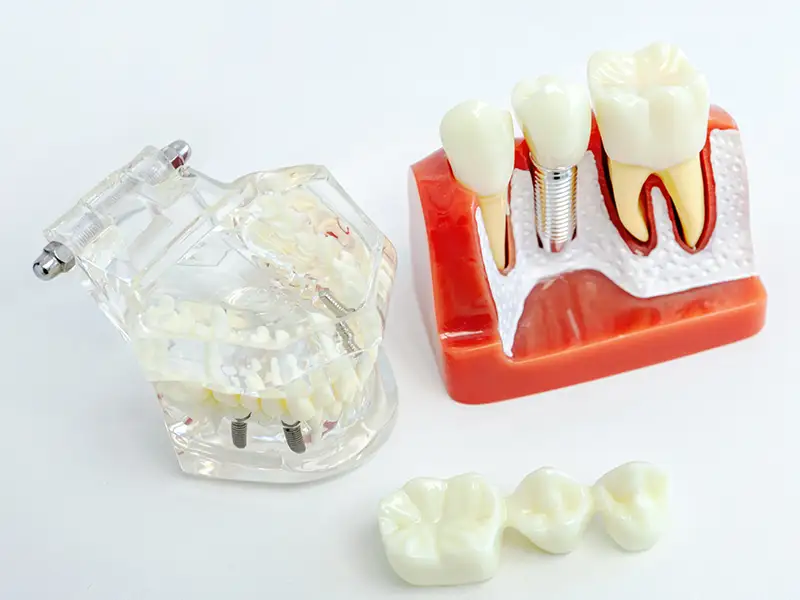Introduction: Missing teeth can affect both your appearance and oral health. Two popular solutions are dental bridges and dental implants. But how do you know which option is right for you? At SFIOS, we’re here to help you make an informed decision based on your specific needs. Dental Bridges: Dental Implants: How Do I Decide? …
Introduction:
Missing teeth can affect both your appearance and oral health. Two popular solutions are dental bridges and dental implants. But how do you know which option is right for you? At SFIOS, we’re here to help you make an informed decision based on your specific needs.
Dental Bridges:
- What Are They?
A dental bridge is a custom-made appliance that replaces one or more missing teeth by bridging the gap. It consists of crowns placed on adjacent teeth and a false tooth (pontic) in between. - Advantages:
- Less invasive than implants.
- Faster installation process.
- Cost-effective compared to implants.
- Considerations:
- Requires preparation of adjacent teeth.
- May need replacement over time.
Dental Implants:
- What Are They?
Dental implants are titanium posts surgically placed into the jawbone to replace missing teeth. They provide a permanent solution that looks and feels natural. - Advantages:
- Long-lasting and durable.
- Preserves jawbone structure.
- No need to alter adjacent teeth.
- Considerations:
- More invasive procedure.
- Longer healing time.
- Higher upfront cost.
How Do I Decide?
Factors to consider when choosing between bridges and implants include:
- Oral Health: The condition of your remaining teeth and jawbone.
- Budget: Cost considerations and insurance coverage.
- Desired Outcome: How long do you want your solution to last?
Step-by-Step Guide to Decision-Making:
- Assess Your Oral Health:
- Evaluate the condition of your remaining teeth and jawbone.
- Consider whether you need immediate tooth replacement or can wait for implant placement.
- Evaluate Budget and Insurance:
- Check if your insurance covers implants or bridges.
- Compare the total costs of each option, including maintenance and potential future repairs.
- Consult with Your Surgeon:
- Schedule a consultation to discuss your options.
- Ask about recovery times, potential complications, and long-term benefits.
Real Patient Experiences:
Here’s what some of our patients have said about their experience with dental bridges and implants at SFIOS:
- JM:
“Dr. Daya and his team go beyond just providing dental care—they make you feel like you’re being looked after by real people who truly care. After losing a molar, I opted for a dental implant, and it was hands down the best decision. The implant looks and feels completely natural, and the staff walked me through every step of the process.” - Anonymous Patient:
“I chose a dental bridge because it was less expensive and quicker to install. It works well for my needs, and I’m happy with the results. The team at SFIOS explained everything clearly and made sure I felt comfortable during the procedure.” - Robert K.:
“I went with dental implants because they’re permanent and preserve my jawbone. The recovery was longer, but it was worth it for the long-term benefits. Dr. Donado was amazing—she kept me informed and made sure I was pain-free throughout the process.” - Laura P.:
“The South Florida Institute of Oral Surgery does great work and provides an excellent experience. Lina was very kind and welcoming, with a beautiful smile that made the visit even more pleasant. Abby took the time to explain my treatment plan in detail, and I decided on a bridge for my missing tooth. Highly recommend this service to everyone!”
Why Choose SFIOS for Tooth Replacement?
At SFIOS, we pride ourselves on offering personalized care tailored to your unique needs. Whether you choose a dental bridge or an implant, our team ensures you receive the highest standard of care. Here’s why patients trust us:
- Expertise: Our surgeons are board-certified and highly trained in advanced procedures.
- Technology: We use state-of-the-art equipment like CT machines and CEREC systems for precise results.
- Comfort: Our friendly staff prioritizes your comfort and addresses all your concerns.
Conclusion:
Both dental bridges and implants are excellent options, but the best choice depends on your individual circumstances. At SFIOS, our experienced team will evaluate your situation and recommend the most suitable solution for your needs. Don’t hesitate to schedule a consultation to learn more.
📞 Contact Us:
- Coral Springs: (954) 280-5957
- Pompano Beach: (954) 466-4764
What is a dental bridge?
A dental bridge is a prosthetic device that “bridges” the gap created by missing teeth. Typically, it uses crowns on the adjacent healthy teeth as anchors and a false tooth (or teeth) in between. It restores appearance and basic function more quickly and often at a lower upfront cost compared with implants.What is a dental implant?
A dental implant is a titanium (or other material) post placed into the jawbone, which acts like a tooth root. After healing (osseointegration), an abutment and crown are attached, resulting in a replacement tooth that mimics a natural tooth in form, function and health of the surrounding bone.Comparing the two: pros and cons
Dental Bridges – Pros:
- Faster to complete (can often be done in weeks)
- Lower initial cost than implant placement in many cases
- Doesn’t require surgery (beyond tooth preparation of the adjacent teeth)
- Requires altering (shaving down) healthy adjacent teeth for the crowns
- Doesn’t preserve bone in the gap—over time, the bone may resorb leading to changes in facial appearance or gum contours
- Lifespan can be shorter (often 10–15 years) and may require replacement
- Mimics natural tooth root, preserving bone and preventing resorption
- Doesn’t compromise adjacent teeth (no shaving down)
- Longer lifespan (many last for decades with good care)
- Better chewing efficiency and comfort in many cases
- More expensive upfront
- Requires surgery and a healing period (several months)
- Longer time to final restoration compared with a simple bridge
Dental Bridges – Cons:
Dental Implants – Pros:
Dental Implants – Cons:
How to decide what’s best for you
- Bone volume and health: If you have sufficient jawbone, implants are often the ideal. If bone is deficient, grafting may be needed (see our previous post).
- Adjacent teeth condition: If the teeth next to the gap are weak, heavily filled or already crowned, a bridge may make sense.
- Budget and timeline: If cost and speed are top priorities and future maintenance is acceptable, a bridge may be selected.
- Long-term goals: If your priority is long-term stability, preservation of bone and minimal impact on other teeth—an implant may be worth the investment.
- Medical and surgical suitability: Some patients may not be candidates for implants due to systemic health issues — a thorough consultation can clarify.




